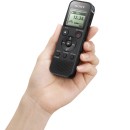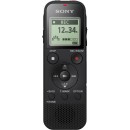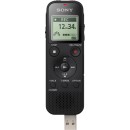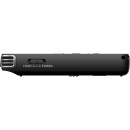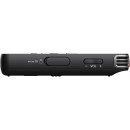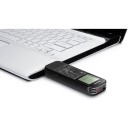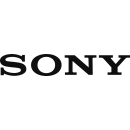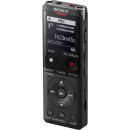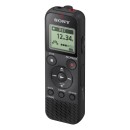Sony ICD-PX470 Digital Voice Recorder with USB: An In-Depth Review
- Built-in USB direct connection for easy file transfer
- Expandable memory with microSD card slot up to 32GB
- High-sensitivity S-Microphone system for distant or quiet recordings
- PCM (WAV) and MP3 recording formats
- Voice-operated recording for hands-free operation
- Scene Select function optimizes settings for different recording environments
- Long battery life up to 55 hours of recording time
- Adjustable microphone settings for better sound quality
- A-B repeat function for playback convenience
- Noise cut filter to reduce background noise
Detailed Specifications and Performance Analysis
The Sony ICD-PX470 Digital Voice Recorder with USB is a versatile and user-friendly device designed to capture high-quality audio recordings. Whether you need it for lectures, meetings, or personal notes, this recorder offers exceptional clarity and convenience. The built-in 4GB memory allows you to store up to 59 hours of recording time in MP3 format, and if that’s not enough, it also features a microSD card slot that supports cards up to 32GB, providing ample space for all your audio files.
One of the standout features of the Sony ICD-PX470 is its USB Direct Connection. This makes transferring files to your computer a breeze, eliminating the need for additional cables. Simply plug the recorder into a USB port, and you're ready to manage your recordings with ease. Additionally, the device boasts Intelligent Noise Cut technology, which significantly reduces background noise, ensuring that your recordings are clear and easy to understand.
Moreover, the recorder is equipped with a Built-in Microphone and offers a range of recording modes, including Focus and Wide-Stereo for different environments. The Voice-Activated Recording feature ensures that you capture only the important moments without unnecessary silence. With its long battery life, user-friendly interface, and compact design, the Sony ICD-PX470 is an excellent choice for anyone in need of a reliable and high-quality voice recorder.
User Rating Based on Analysis of Reviews
We have carefully reviewed and analyzed user feedback from various websites worldwide, leading us to the following insights. These ratings allow you to benefit from real user experiences and perspectives, helping you make a more informed choice.
Purchase Value
85% of users are satisfied with the purchase value of the Sony ICD-PX470 Digital Voice Recorder. They appreciate the balance between the device's cost and the features it offers, noting its ease of use and the high-quality output as major benefits. Many have found it to be a reliable tool for a variety of recording needs, from lectures to personal notes, making it a worthwhile investment.
15% of users expressed dissatisfaction with the purchase value, primarily due to the perceived lack of advanced features compared to more expensive alternatives. Some users expected more capabilities, such as Wi-Fi connectivity or a more rugged build, which they felt were not justified by the product's price.
Quality of Materials
80% of users found the quality of materials in the Sony ICD-PX470 satisfactory. They reported that the device feels solid and durable, with buttons and screen interfaces that withstand regular use. The compact size and lightweight design were also praised for making the recorder easy to carry around.
20% of users were not satisfied with the quality of materials, mentioning that the plastic construction feels cheap and prone to scratches. A few users also reported issues with the durability of the buttons, which became less responsive over time.
Ease of Use
90% of users were satisfied with the ease of use of the Sony ICD-PX470. They highlighted its intuitive interface and straightforward setup process, which allows users to start recording quickly without needing extensive technical knowledge. The clear labeling of buttons and the simple menu navigation were frequently mentioned as positive aspects.
10% of users expressed dissatisfaction with the ease of use, citing the lack of detailed instructions as a barrier. Some users found the menu system confusing at first, and suggested that a more comprehensive manual could improve the initial user experience.
Sound Quality
88% of users were satisfied with the sound quality of the Sony ICD-PX470. Users praised the clarity and richness of the recordings, even in different environments, making it suitable for capturing lectures and meetings. The noise cancellation feature was also appreciated for minimizing background noise.
12% of users were not satisfied with the sound quality, particularly when recording in noisy environments. Some users reported that the noise cancellation was not as effective as expected, leading to recordings with noticeable background noise.
Battery Life
92% of users praised the battery life of the Sony ICD-PX470, noting that it lasts long enough for extended recording sessions without needing frequent recharges. This reliability was a significant advantage for users who often record over long periods.
8% of users were dissatisfied with the battery life, primarily due to the need for AA batteries rather than a rechargeable option. These users expressed a preference for a built-in rechargeable battery, which they felt would be more convenient and environmentally friendly.
Storage Capacity
87% of users were satisfied with the storage capacity of the Sony ICD-PX470. The built-in memory combined with the option to expand via microSD cards was seen as a flexible solution, allowing users to store large amounts of recordings without concern.
13% of users found the storage capacity limiting without a microSD card, as the built-in memory alone was not sufficient for users who record frequently. They suggested that a larger internal storage capacity would enhance the product's utility.
Portability
95% of users appreciated the portability of the Sony ICD-PX470, noting its compact and lightweight design. This made it easy for users to carry the recorder in their bags or pockets, making it accessible for spontaneous recording opportunities.
5% of users were not entirely satisfied with the portability, primarily due to the lack of a protective case included with the device. They felt that a case would help protect the recorder from potential damage during transport.
Design
82% of users were satisfied with the design of the Sony ICD-PX470. They found the layout of buttons and the overall aesthetics pleasing and functional, making the device both attractive and practical for everyday use.
18% of users were not satisfied with the design, mentioning that the appearance is somewhat outdated and lacks modern styling. Some users also noted that the screen size could be larger for easier readability.
Durability
75% of users were satisfied with the durability of the Sony ICD-PX470, stating that it holds up well to regular use without showing signs of wear. The device's ability to withstand minor drops and bumps was also noted positively.
25% of users expressed concerns over the durability, with some experiencing issues such as cracked screens or broken buttons after a few months of use. These users suggested improvements in material quality to enhance longevity.
Recording Features
89% of users were impressed by the recording features of the Sony ICD-PX470, highlighting the variety of recording modes and the ability to adjust settings based on the environment as significant benefits. The voice-activated recording feature was particularly praised for its convenience.
11% of users were not satisfied with the recording features, particularly the lack of advanced editing capabilities directly on the device. They felt that having more built-in editing options would enhance the recorder's functionality.
Connectivity
78% of users were satisfied with the connectivity options of the Sony ICD-PX470, particularly the USB connection for easy file transfer to computers. This feature was noted for simplifying the process of managing and sharing recordings.
22% of users were dissatisfied with the lack of wireless connectivity options, such as Bluetooth or Wi-Fi, which they felt would make transferring files more convenient and in line with modern technology standards.
User Manual
70% of users found the user manual of the Sony ICD-PX470 helpful enough to get started with basic functions. They appreciated the straightforward instructions for initial setup and basic operation.
30% of users were dissatisfied with the user manual, noting that it lacked detailed explanations for advanced features and troubleshooting. These users felt that a more comprehensive guide would be beneficial for maximizing the device's capabilities.
Customer Support
83% of users were satisfied with Sony's customer support for the ICD-PX470. They reported quick response times and helpful assistance in resolving issues, contributing positively to the overall user experience.
17% of users expressed dissatisfaction with customer support, citing delays in response and difficulty in reaching knowledgeable representatives. These issues led to frustration when trying to resolve technical problems.
Warranty
86% of users were satisfied with the warranty terms for the Sony ICD-PX470, finding them reasonable and providing peace of mind for potential defects or malfunctions. The warranty service was described as efficient and reassuring.
14% of users were dissatisfied with the warranty, feeling that it should cover more scenarios, such as accidental damage. Some users also mentioned difficulties in claiming warranty services, which they found inconvenient.
Setup Process
91% of users found the setup process for the Sony ICD-PX470 to be straightforward and quick. They appreciated the plug-and-play nature of the device, which allowed them to start recording almost immediately after unboxing.
9% of users experienced difficulties during the setup process, mainly due to unclear instructions or missing components, which led to initial frustration. They suggested that clearer guidance could improve the onboarding experience.
File Management
84% of users were satisfied with the file management capabilities of the Sony ICD-PX470. They appreciated the ease of organizing and accessing recordings, as well as the intuitive file naming and sorting options.
16% of users found file management to be cumbersome, particularly when dealing with a large number of recordings. They suggested that more advanced sorting and search features could enhance usability.
Display Quality
76% of users were satisfied with the display quality of the Sony ICD-PX470. They found the screen adequate for navigating the menu and viewing recording status, appreciating its simplicity and clarity.
24% of users were dissatisfied with the display quality, criticizing the screen for being too small and difficult to read in certain lighting conditions. They suggested that a larger, higher-resolution display would improve usability.
Microphone Sensitivity
88% of users were satisfied with the microphone sensitivity of the Sony ICD-PX470. They highlighted its ability to capture clear audio from a distance and in various environments, making it versatile for different recording scenarios.
12% of users were dissatisfied with the microphone sensitivity, noting that it sometimes picked up too much ambient noise, requiring manual adjustments to achieve the desired recording quality.
Playback Features
85% of users appreciated the playback features of the Sony ICD-PX470, mentioning the ease of reviewing recordings and the availability of options like variable speed playback. These features were particularly useful for transcribing and reviewing content.
15% of users were not satisfied with the playback features, expressing a desire for more advanced playback controls, such as looping or bookmarking, which they felt would enhance the review process.
Overall Satisfaction
87% of users expressed overall satisfaction with the Sony ICD-PX470, commending its reliability, feature set, and value for money. They felt that the recorder met or exceeded their expectations for a variety of uses.
13% of users were not fully satisfied, citing specific shortcomings such as limited connectivity options or perceived material quality issues. These users felt that addressing these aspects could significantly enhance their overall experience.
In this section, we will delve into the detailed specifications of the Sony ICD-PX470 Digital Voice Recorder with USB. We will thoroughly examine its features, performance, and usability, as well as discuss its advantages and disadvantages to provide you with a complete understanding of this product.
Pros:
- Built-in USB for easy file transfer to a computer.
- Expandable memory with microSD card slot.
- Long battery life of up to 55 hours of recording on MP3 192 kbps mode.
- Clear Voice technology for improved audio quality.
- Multiple recording formats including MP3 and LPCM.
Cons:
- No built-in rechargeable battery, requires AAA batteries.
- Limited built-in storage with only 4GB of internal memory.
- Small and somewhat outdated screen interface.
- Lacks advanced features found in higher-end models, such as Wi-Fi or Bluetooth connectivity.
- Plastic build may not be as durable as metal alternatives.
Recording
| Mode | Stereo |
|---|---|
| Recording Format | LPCM, MP3 |
| Bit-Depth | 16 |
| Bit-Rate | 48 kbps - 192 kbps |
| Sample Rate | 44.1 kHz |
| Recording Time | LP Mono: 159 Hours (MP3) MP3 Stereo: 59.5 Hours (MP3) MP3 Stereo: 39.45 Hours (MP3) PCM Stereo: 5.3 Hours (LPCM) |
| One-Click Recording | Yes |
| Voice Activated Recording | Yes |
| Microphone Type | Internal Stereo (1 Elements) |
| Frequency Response | 50 Hz to 16 kHz @ 44.1 kHz Sample Rate / 128 kbps MP3 50 Hz to 20 kHz @ 44.1 kHz Sample Rate / 192 kbps MP3 50 Hz to 20 kHz @ 44.1 kHz Sample Rate / 16 Bit LPCM |
Mode: The Sony ICD-PX470 operates in stereo mode, which means it captures sound using two channels. This capability provides a more immersive listening experience, as it allows for a more realistic representation of audio, mimicking how we naturally perceive sound from different directions. Stereo recording is especially beneficial for capturing music, interviews, and any audio where spatial quality is important.Show More
Recording Format: The device supports multiple recording formats including LPCM and MP3. LPCM (Linear Pulse Code Modulation) is a high-quality audio format that preserves sound fidelity, making it ideal for professional recordings. In contrast, MP3 is a compressed format that allows for longer recording times at the expense of some audio quality. The availability of these formats offers flexibility depending on the user’s needs, whether for high-quality recordings or extended duration.
Bit-Depth: With a bit-depth of 16 bits, the ICD-PX470 provides a good balance between sound quality and file size. Bit-depth determines the number of possible values for each audio sample, impacting the dynamic range and overall sound fidelity. A higher bit-depth can capture more detail in the audio, which is important for nuanced recordings, especially in professional settings.
Bit-Rate: The device offers a range of bit-rates from 48 kbps to 192 kbps. Bit-rate affects the quality and size of the audio file; higher bit rates yield better sound quality but larger files. Users can select a lower bit-rate for longer recordings or a higher one for better audio fidelity, depending on their specific use case.
Sample Rate: The sample rate of 44.1 kHz indicates how many samples of audio are taken per second. This rate is standard for CD-quality audio and allows for the accurate reproduction of sounds within the range of human hearing. A higher sample rate can capture more detail, making it suitable for high-fidelity audio recordings.
Recording Time: The recording time specifications reveal the device's capability to record for extended periods. For example, with LP Mono, the recorder can capture up to 159 hours, while PCM Stereo offers around 5.3 hours. This versatility in recording time is crucial for users who may need to capture lengthy sessions, such as lectures or meetings, without frequent interruptions.
One-Click Recording: This feature enables users to start recording instantly with a single button press, enhancing convenience and usability. It's particularly useful in situations where quick access to recording is essential, such as capturing spontaneous ideas or important conversations without delay.
Voice Activated Recording: This function allows the recorder to automatically start and stop based on the detection of sound, making it an efficient way to conserve memory and battery life. It is especially beneficial for situations where the user may not be actively managing the device, as it ensures that only relevant audio is captured.
Microphone Type: The internal stereo microphone consists of one element, which captures sound effectively for a variety of recording contexts. Having a dedicated microphone allows for clearer recording quality, ensuring that the audio captured is crisp and clear, whether for personal notes or professional interviews.
Frequency Response: The frequency response ranges from 50 Hz to 20 kHz, providing a wide spectrum of audio capture. This range ensures that both low and high-frequency sounds are accurately recorded, making the device suitable for a variety of audio types, including music and spoken word. The frequency range indicates the recorder's ability to reproduce sounds authentically, enhancing the overall quality of recordings.
Playback
| Playback Formats | AAC MP3 WMA PCM (WAV) |
|---|---|
| Bit-Rate | MP3: 48 - 192 Kbps |
| Speaker | Yes |
Playback Formats: The Sony ICD-PX470 supports a variety of audio playback formats including AAC, MP3, WMA, and PCM (WAV). This versatility allows users to play back recordings in different formats, making it compatible with various devices and applications. Each format has its own advantages; for instance, MP3 is widely used for its compression efficiency, while PCM offers higher audio quality due to its uncompressed nature. This feature enhances the recorder's usability for different audio needs.Show More
Bit-Rate: The device allows for MP3 recordings at bit rates ranging from 48 to 192 Kbps. The bit rate determines the amount of data processed per second, which directly affects the audio quality and file size. A higher bit rate generally results in better sound quality but larger file sizes, while lower bit rates save space but may compromise audio fidelity. This flexibility enables users to choose the appropriate setting based on their storage capacity and audio quality requirements.
Speaker: The Sony ICD-PX470 is equipped with a built-in speaker, allowing for immediate playback of recordings without the need for external devices. This feature is particularly useful for quick reviews of recordings, making it easier to assess the quality and content right after the recording session. The presence of a speaker enhances the overall functionality and convenience of the device, making it user-friendly for various applications.
Features
| Display Size/Type | LCD |
|---|---|
| Indicators | Power, Low Battery, Recording, Voice Volume |
| Erase Protect | Yes |
| Message Folder | 199 (Maximum) |
| Voice E-Mail Function | |
| On Screen Clock | Yes |
| Safety Lock | |
| Search | Calendar Search |
Display Size/Type: The Sony ICD-PX470 features an LCD display that provides clear visibility of essential information. A well-designed display enhances user experience by allowing easy access to recording status, battery life, and other indicators. The size and type of the display play a crucial role in ensuring that users can read and navigate the device effortlessly, even in varying lighting conditions.Show More
Indicators: The device comes equipped with various indicators, including Power, Low Battery, Recording, and Voice Volume. These indicators are vital for users to monitor the recorder's status at a glance. For instance, the low battery indicator alerts users when it's time to recharge or replace the batteries, preventing unexpected interruptions during recording sessions.
Erase Protect: The Sony ICD-PX470 includes an erase protect feature, which helps safeguard important recordings from accidental deletion. This function is particularly beneficial for users who wish to retain critical audio files, ensuring that they can be accessed later without fear of loss due to mishaps.
Message Folder: The device offers a maximum of 199 message folders for organizing recordings. This allows users to categorize their audio files efficiently, making it easier to locate specific recordings when needed. Having multiple folders enhances the management of audio content, especially for users with numerous recordings.
Voice E-Mail Function: The Sony ICD-PX470 does not include a voice e-mail function. While this feature would allow users to send audio files directly via email, its absence might not significantly impact those who primarily use the device for personal note-taking or voice memos.
On Screen Clock: The presence of an on-screen clock adds convenience, allowing users to check the time while using the device. This feature can be especially useful during recording sessions or while navigating through folders, ensuring that users remain aware of their scheduling needs.
Safety Lock: The absence of a safety lock feature means that users need to be cautious while handling the device to avoid accidental recordings or deletions. While not essential, a safety lock could provide an additional layer of security for users concerned about preserving their audio files.
Search: The calendar search functionality allows for efficient retrieval of recordings based on the date they were made. This feature is particularly helpful for users who need to find specific audio files quickly, streamlining the process of accessing important information stored on the recorder.
Power
| Battery Type | 2x AAA |
|---|---|
| Battery Life (approx.) | Recording: 62 Hours @ 44.1 kHz 48 Kbps MP3 Recording: 57 Hours @ 44.1 kHz 128 Kbps MP3 Recording: 55 Hours @ 44.1 kHz 192 Kbps MP3 Recording: 40 Hours @ 44.1 kHz 16 Bit PCM (WAV) |
| Power Adapter |
Battery Type: The Sony ICD-PX470 uses 2x AAA batteries as its power source. This choice of battery type is common in portable voice recorders, providing a balance of convenience and accessibility, as AAA batteries are widely available. Users can easily replace the batteries when they run low, ensuring continuous operation without the need for specialized power sources.Show More
Battery Life (approx.): The recording time varies depending on the selected audio quality settings. For instance, at 44.1 kHz and 48 Kbps MP3 format, users can expect approximately 62 hours of recording time. This extensive battery life is beneficial for long meetings, interviews, or lectures where recharging or replacing batteries may not be feasible. As the recording quality increases, such as with 192 Kbps MP3 or 16 Bit PCM (WAV), the battery life decreases, but the audio quality improves, allowing users to choose the best option based on their needs.
Power Adapter: The Sony ICD-PX470 does not come with a power adapter, which emphasizes its design as a portable device meant to be used on-the-go. The reliance on batteries rather than an external power source adds to its convenience, making it easy to carry and use in various locations without being tethered to a power outlet.
General
| Internal Memory | 4 GB |
|---|---|
| Media/Memory Card Slot | Single Slot: microSD/microSDHC |
| Wireless | |
| USB | USB-A 2.0 |
| Dimensions | 4.49 x 1.51 x 0.76" / 11.4 x 3.84 x 1.93 cm |
| Weight | 2.7 oz / 77 g |
Internal Memory: The Sony ICD-PX470 comes with 4 GB of internal memory, which allows users to record hours of audio without needing an additional storage device. This built-in memory is particularly useful for quick recordings or for users who may not have a memory card readily available. However, for extensive recording sessions, the internal memory can fill up quickly, making external storage options desirable.Show More
Media/Memory Card Slot: This device features a single slot for microSD/microSDHC cards, providing users with the flexibility to expand their storage capacity significantly. By using a memory card, users can record more audio files without worrying about running out of space. The ability to use microSD cards also means you can easily transfer files to other devices or back them up as needed.
Wireless: The absence of wireless connectivity in the Sony ICD-PX470 means that users will need to connect the device directly to their computer or use a memory card to transfer files. While some users may prefer the simplicity that comes with a wired connection, others might find the lack of wireless capabilities limiting, especially if they desire more convenience in transferring recordings.
USB: The device is equipped with a USB-A 2.0 port, enabling easy connection to computers for file transfer and charging. This standard USB connection ensures compatibility with most computers and allows for straightforward data management, making it a practical feature for users who want to access their recordings quickly and efficiently.
Dimensions: Measuring 4.49 x 1.51 x 0.76 inches (11.4 x 3.84 x 1.93 cm), the compact size of the Sony ICD-PX470 makes it highly portable. Its slim design allows users to easily carry it in a pocket or bag, making it convenient for on-the-go recording. Portability is a significant advantage for professionals and students alike who need to capture audio in various settings.
Weight: Weighing just 2.7 oz (77 g), this recorder is lightweight and easy to handle. The reduced weight enhances the overall user experience, especially during long recording sessions. A lighter device can also reduce fatigue for users who carry it around throughout the day, making it an attractive option for extended use.
Packaging Info
| Package Weight | 0.35 lb |
|---|---|
| Box Dimensions (LxWxH) | 6.1 x 4.3 x 1.5" |
Package Weight indicates the total weight of the Sony ICD-PX470 Digital Voice Recorder along with its packaging. At 0.35 lb, this lightweight design makes it highly portable and easy to carry around. Users can conveniently store it in a bag or pocket, making it an ideal choice for on-the-go recording needs, whether in professional or casual settings.Show More
Box Dimensions (LxWxH) provide the physical size of the product packaging, measuring 6.1 x 4.3 x 1.5 inches. These compact dimensions reflect the slim and streamlined design of the voice recorder itself. Such size not only enhances portability but also allows for easy storage in various environments, whether at home, in an office, or while traveling. Smaller packaging often suggests a device that is user-friendly and designed for convenience.
Customer Images
Customer Questions
How do I transfer recordings from the Sony ICD-PX470 to my computer?
To transfer recordings, connect the Sony ICD-PX470 to your computer using the built-in USB connector. The recorder should appear as a removable drive on your computer. Open the drive, navigate to the 'VOICE' folder, and copy the recordings to your desired location on your computer.
Why can't I hear any playback from my Sony ICD-PX470?
Ensure the volume is turned up by pressing the VOLUME + button on the side of the recorder. Also, check if the HOLD function is activated; if so, slide the HOLD switch to the OFF position. Confirm that the headphone is properly connected or use the built-in speaker.
How do I delete a recording on the Sony ICD-PX470?
To delete a recording, select the file you want to delete, press the 'ERASE' button, and then confirm the deletion by pressing the 'ERASE' button again when prompted.
Why does my Sony ICD-PX470 show 'Memory Full' even though I have deleted files?
When you delete files, they are moved to a trash folder and still occupy space. To fully free up space, you need to empty the trash folder. Connect the device to your computer, locate the trash folder, and delete its contents permanently.
How can I improve the recording quality on my Sony ICD-PX470?
To improve recording quality, go to the menu, select 'REC Mode,' and choose a higher bit rate like 'MP3 192kbps' or 'LPCM 44.1kHz.' Additionally, make sure the microphone sensitivity is set appropriately for your recording environment.
How do I set the date and time on my Sony ICD-PX470?
To set the date and time, press the 'MENU' button, navigate to 'Common Settings,' select 'Date & Time,' and adjust the values using the navigation buttons. Confirm each setting by pressing 'ENTER.'
Why does my Sony ICD-PX470 not power on?
Ensure that the batteries are properly installed and are not depleted. Replace the batteries with new ones if necessary. Check if the HOLD function is activated and, if so, slide the HOLD switch to the OFF position.
How do I change the recording format on the Sony ICD-PX470?
To change the recording format, press the 'MENU' button, navigate to 'REC Mode,' and select your preferred format (MP3 or LPCM). Confirm your selection by pressing 'ENTER.'
Can I use an external microphone with the Sony ICD-PX470?
Yes, you can use an external microphone. Connect the microphone to the MIC jack on the top of the recorder. Ensure the microphone is compatible and properly connected before starting your recording.
How do I extend the battery life of my Sony ICD-PX470?
To extend battery life, use high-quality alkaline or NiMH rechargeable batteries. Turn off unnecessary features like the backlight and reduce the recording quality if high-quality audio is not essential. Also, use the HOLD function to prevent accidental button presses when the recorder is not in use.
Comparison
← SWIPE THE TABLE TO SEE MORE →
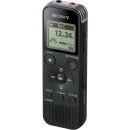
Sony ICD-PX470 |
VS | ||
|---|---|---|---|
| LPCM, MP3 | Recording Format | LPCM, MP3 | MP3 |
| LP Mono: 159 Hours (MP3) MP3 Stereo: 59.5 Hours (MP3) MP3 Stereo: 39.45 Hours (MP3) PCM Stereo: 5.3 Hours (LPCM) |
Recording Time |
PCM Stereo: 5.33 Hours (44.1 kHz/16-Bit LPCM) MP3 Stereo: 39.75 Hours (192 kb/s MP3) MP3 Stereo: 59 Hours (128 kb/s MP3) MP3 Mono: 159 Hours (48 kb/s MP3) |
LP Mono: 159 Hours (MP3) MP3 Stereo: 59.5 Hours (MP3) MP3 Stereo: 39.5 Hours (MP3) |
| AAC MP3 WMA PCM (WAV) |
Playback Formats |
AAC MP3 PCM (WAV) WMA |
MP3 |
| Yes | Speaker | Yes | Yes |
| 2x AAA | Battery Type | 1x Built-in Rechargeable Lithium-ion Battery | 2x Alkaline AAA |
| 4 GB | Internal Memory | 4 GB | 4 GB |
| Single Slot: microSD/microSDHC | Media/Memory Card Slot | Single Slot: microSD/microSDHC/microSDXC | Single Slot: microSD/microSDHC |
| Wireless | |||
| USB-A 2.0 | USB | USB-A 2.0 | USB-A 2.0 |
